Ann Arbor sets goal of reducing greenhouse gas emissions by 90% by 2050
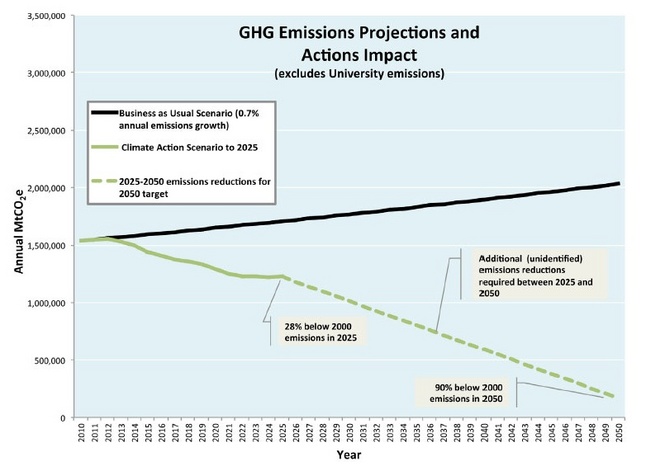
A look at how Ann Arbor's carbon footprint could change over time depending on whether action items recommended in the Climate Action Plan are implemented.
City of Ann Arbor
The Ann Arbor City Council took action Monday night to adopt a Climate Action Plan, a 188-page document that outlines dozens of ways to reduce the community's carbon footprint.
Building on previous environmental goals set by the City Council, the new plan recommends three targets for reducing greenhouse gas emissions in the coming decades.
That includes a goal of reducing the entire community's emissions by 8 percent by 2015, by 25 percent by 2025, and by 90 percent by 2050 — all relative to 2000 baseline levels.
"Climate change is real and happening now," said Wayne Appleyard, chairman of the Ann Arbor Energy Commission, one of the groups that worked to develop the plan over the past year.
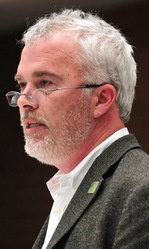
Matt Naud
Download the full plan at www.a2energy.org/climate.
The City Council last year established a goal of getting 30 percent of the energy for the city's own municipal operations from renewable sources by 2015. The council also established a goal of reducing greenhouse gas emissions from municipal operations by 50 percent by 2015, so the city is setting a higher bar for itself than residents and businesses.
But to achieve the long-term target of a 90 percent communitywide reduction in greenhouse gas emissions, city officials acknowledge major shifts must occur — changes that most likely eliminate reliance on fossil fuels by the building and transportation sectors.
The new Climate Action Plan recommends strategies that could influence the way Ann Arborites live. For example, a program that incentivizes employees and residents to live within two miles of their jobs, as well as new incentives for mixed-use and transit-oriented development. Another idea mentioned is a community bike-sharing program.
The plan also calls for providing incentives for use of public transit, and enhancing transit service, including more weekend and evening service.
As far as resource management, the plan recommends adoption of a new water conservation ordinance, reducing residential trash pickup to bi-weekly and encouraging residents to place garbage, recycling, and compost carts out for collection only when full.
The plan also recommends increasing local food production and consumption, and promoting "climate impact" labeling for restaurants, as well as other businesses.
Through such a program, the city could partner with researchers at the University of Michigan to develop standards and label products to include details about their place of origin, transport miles and estimates of the amount of energy used to produce, transport and deliver them.
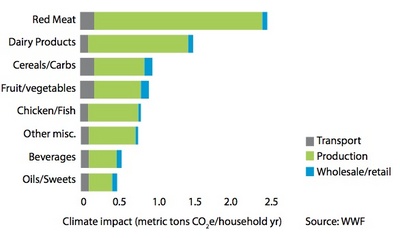
This chart from the city's Climate Action Plan shows an example of how the city might convey the environmental impacts of different dietary choices through a proposed food labeling program.
City of Ann Arbor
The plan also recommends generating better local air quality data and implementing a vehicle idling reduction ordinance to improve air quality. That's an idea the City Council considered before.
Matt Naud, the city's environmental coordinator, said if Michigan voters had approved Proposal 3 last month to set a new statewide renewable energy standard (25 percent by 2025), then Ann Arbor would be well on its way to meeting many of the goals in the new plan.
"Since that didn't pass, we're going to be looking for opportunities to maybe partner with a wind farm," Naud said, adding it would take three windmills to run both the city's wastewater and water plants, which are two of the biggest energy users in the city.
Naud said it make sense for the city to figure out whether there are some large-scale renewable energy projects with which the city can get involved.
"We've done a huge amount of energy efficiency and we haven't really seen cost savings because energy prices are rising faster than we can do the efficiency work," he said.
The city estimates the Ann Arbor community — excluding the University of Michigan — spends about $140 million annually on natural gas and electricity. City officials note that's money that leaves the community because most of Ann Arbor's energy is not generated locally.
Naud has long stated basic energy efficiency investments could save 10 percent and keep $14 million per year circulating in the local economy.
With the average Ann Arbor household spending roughly $1,600 each year for home energy needs, a 10 percent reduction translates to $160 in savings for the average household.
"That's something we should probably be paying attention to for economic development reasons," Naud said. "Not to mention it's local contractors that are doing that work."
In terms of implementing recommendations of the Climate Action Plan, any future investments of city funds exceeding $25,000 must go before City Council for approval prior to initiation. Naud said some items could save the city money, some could cost the city money, and some could be break-even.
The Climate Action Plan calls for weatherizing the existing housing stock in Ann Arbor and offering incentives for energy audits and implementation of energy conservation measures.
It also suggests strengthening housing code energy standards for rental properties and expanding and enforcing a city ordinance that requires landlords to provide energy budgets to tenants. Another goal is to implement a "Residential Energy Conservation Ordinance" with required upgrades.
Creation of a downtown geothermal heating and cooling district also is contemplated, along with solar incentives. On the renewable energy front, the plan calls for working with the Michigan Public Service Commission and DTE Energy to allow direct purchase of renewable energy by residents and implementing more community renewable energy projects.
In 2006, the City Council passed a resolution setting a goal of having 5,000 solar roofs in the city by 2015. The resolution focused on solar hot water heaters, but the Climate Action Plan now recommends expanding the scope to also include photovoltaics.
If every residential building in Ann Arbor had a one-kilowatt solar electric system on its roof, the new plan concludes, the community could generate more than 30 million kilowatt-hours of clean electricity each year — nearly 10 percent of the residential demand.
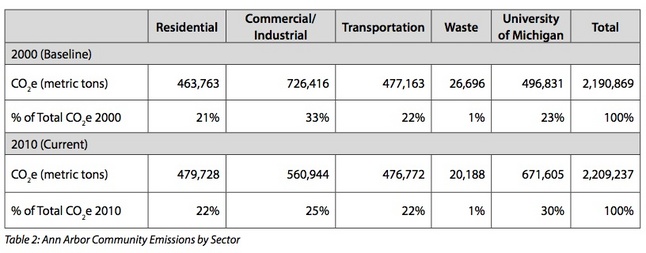
The Climate Action Plan offers this snapshot of greenhouse gas emissions in the community in both 2000 and 2010.
City of Ann Arbor
Hutton said that means residents and businesses, as well as the University of Michigan, have a big role to play. She said it's the city's task to lead by example.
"Ninety-seven percent of scientists agree that climate change is caused by humans," she said. "We're making this happen and we need to start to make it stop."
Appleyard said he's not sure "climate change" is a strong enough term to convey the magnitude of the situation. He said "climate destabilization" or "climate collapse" might be more accurate.
"Over the past year while working on the plan, a series of scientific studies and actual events — including Hurricane Sandy and the national drought — have shown us that climate change and the resulting changes in weather patterns, and the ecosystems upon which we all depend for continued life on planet earth, are happening faster than anyone had predicted," he said.
Naud said there are a number of "no regrets" actions included in the Climate Action Plan that the city can take, meaning they're items that make sense to do regardless of whether one believes in climate change. Some examples include addressing flooding concerns by upgrading aging stormwater infrastructure, increasing capacity for wastewater collection and treatment, and promoting rainwater collection. The plan also mentions actions that help remedy air pollution problems.
"What we'll be looking to do is continuously evaluate where those opportunities are," Naud said. "We're in discussion with utilities where they want to install solar photovoltaics potentially on city property. That might generate some cash for the city. That cash might be then turned around and reinvested in additional installations that we could use for our own energy use."
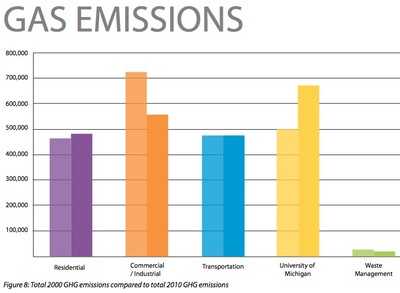
Another look at greenhouse gas emissions in Ann Arbor from the city's newly adopted Climate Action Plan.
City of Ann Arbor
"If you look at where climate emissions come from, most of it's about energy," he said. "A lot of our energy is based on carbon, and anything we can do to move from carbon-based forms of energy to renewable or lower-carbon sources will get us a long way."
Across the United States, Naud said, the real innovation around climate change has been happening at the city level — not the state level — for about the past decade.
"There are ways that each of the cities are looking at their greenhouse gas emissions, how they use energy, and we're going to be looking to do more around community energy planning," he said.
"We've got a big grant from Housing and Urban Development to look at greening rental housing," he said. "We've got a lot of students signing leases when they're 18 — never signed a lease before, don't know anything about the cost of their utilities. How can we better educate them to make better decisions and help drive the market for landlords to invest?"
Naud added, "I think there are some real low-hanging-fruit opportunities that we can take advantage of by just getting out and working with the community."
Separately from the Climate Action Plan, the City Council adopted a clean air resolution Monday night that argues greenhouse gas concentrations already endanger public health and climate change already is responsible for some 300,000 deaths and $125 billion in economic losses each year.
The U.S. Supreme Court ruled in 2007 that the U.S. Environmental Protection Agency has the authority to regulate greenhouse gases. The council's resolution urges the EPA and President Barack Obama to move swiftly to fully enforce the Clean Air Act to reduce carbon in the atmosphere.
"What it does is it joins other communities across the country in asking that the administration use the authority that it has under the Clean Air Act to regulate greenhouse gasses," said Council Member Chuck Warpehoski, D-5th Ward, who co-sponsored the resolution with Sabra Briere.
"This is one more step in a long history of action that we're taking and recognizing that a global problem like climate change is more than we can handle on our own," Warpehoski said.
Both items related to climate change were adopted by 8-0 votes Monday night with Briere and Council Members Marcia Higgins and Margie Teall absent.
Ryan J. Stanton covers government and politics for AnnArbor.com. Reach him at ryanstanton@annarbor.com or 734-623-2529. You also can follow him on Twitter or subscribe to AnnArbor.com's email newsletters.


Comments
Dog Guy
Tue, Dec 18, 2012 : 2 p.m.
All wisdom is incarnate in the petty politicians who run ??????????????-on-Huron. If blight, crime, tax-foreclosures, and potholes were real and happening now, city council certainly would conjure a plan to address city services by 2050.
Roy Munson
Tue, Dec 18, 2012 : 1:58 p.m.
The Peoples' Republic of Ann Arbor is at it again. How about instead of spending all this time and especially resources into a problem that is debatable at best, you do something about the homeless, increased home invasions, street plowing, and on and on.
G. Orwell
Tue, Dec 18, 2012 : 1:53 p.m.
Most likely it is the cyclical changes in the solar output causing climate change. How do the warmists explain the ice age. Did cavemen cause the ice age? Global climate is greatly impacted by natural causes. If you look at earth's history, the earth has been much warmer and CO2 levels were much higher than it is today. Plants and animals thrived. Real environmental dangers are GMOs, nuclear, toxic waste dumping, unregulated fracking, etc. Not global warming. AGW is being used to "legally" steal from the public.
Brad
Tue, Dec 18, 2012 : 1:45 p.m.
"Council Members Marcia Higgins and Margie Teall absent" Hardly news, now is it? I bet Jack Eaton would have been there.
Nicholas Urfe
Tue, Dec 18, 2012 : 1:43 p.m.
What percentage of a2 police patrols are done via bicycle? Get the cops on bikes. Instead of sitting in their cars, cranking the a/c with the windows up, texting... Or whatever it is they are doing in there. Getting them out on the street makes them far more aware of what is happening, and it makes them more accessible to the community. They can move through the community without constantly burning gas. It also raises their awareness of unsafe driving.
Jeffersonian Liberal
Tue, Dec 18, 2012 : 1:20 p.m.
Fools, China just fired up 10 coal energy plants while you were grandstanding.
bluemax79
Tue, Dec 18, 2012 : 12:55 p.m.
what a crock of crap! the earths climate has changed many times over it's history and will again with or WITHOUT humans and their "carbon" footprint. this is just a bunch of people who have money invested in so called "green tech" that want to make their millions off of misinformed lemmings willing to follow their lead. that obama has something to do with it tells us right away it's corrupt and a stupid idea.
Brad
Tue, Dec 18, 2012 : 1:48 p.m.
The Earth's climate has changed many times over history ... sometimes wiping out most of the life in the process. It's that last part that has us worried ...
tdw
Tue, Dec 18, 2012 : 1:12 p.m.
" want to make their millions " really ? Al Gore has no financial interest in it...oh wait, hold on a second....
G. Orwell
Tue, Dec 18, 2012 : 12:36 p.m.
Reducing CO2 is like saying let's reduce O2. CO2 is a naturally occurring and essential gas plants need to grow. What a waste of time and probably lots of money. Don't these people know basic biology? Furthermore, there has been no global warming for the past 16 years according to the East Anglia University that first claimed global warming was occurring. The entire global warming fear mongering is to charge us carbon taxes and implement carbon trading so people like Al Gore can get filthy rich. Another Wall Street swindle.
Fordie
Tue, Dec 18, 2012 : 1:56 p.m.
When I think of the top research operations in the world, East Anglia U always comes to mind. I pay attention to this stuff, and even I had to Google them.
Blue Marker
Tue, Dec 18, 2012 : 1:45 p.m.
So let me get this straight....Al Gore is making money off of C02? And what does this article have to do with Wall Street?
Mike
Tue, Dec 18, 2012 : 12:27 p.m.
"For example, a program that incentivizes employees and residents to live within two miles of their jobs...." Would that also include allowing developers to build large, high rise buildings in the city or just give this lip service while we buy up surrounding land with tax dollars? Football Saturdays should be a thing of the past, art fair brings a lot of pollution with it, vacations should be outlawed unless you can do them within two miles of your house, jet travel should be eliminated since we can meet on-line, that should be a good start................
KJMClark
Tue, Dec 18, 2012 : 12:13 p.m.
Except the transportation emissions most likely follows the incomplete inventory from the past. We should be looking at all emissions within our boundaries, not the much lower emissions of local residents. We probably should be looking at half the emissions of all trips that start or end in our boundaries. As the 2003 SNRE report put it, "estimates of VMT were established for the driving activities of Ann Arbor residents and other local fleets." We do have opportunities to deal with those additional emissions, and activities in Ann Arbor create those emissions. As long as the University pretends they have nothing to do with the commuting habits of their employees despite the parking they provide, and Ann Arbor ignores out of town commuters though our ordinances require parking, there are lots of emissions we're sweeping under the rug. We're also undercutting the value of AATA and nonmotorized transportation for dealing with climate change by ignoring much of the emissions from transportation. On another front, we did install combined heat and power in the new municipal building, right? We are looking at biomass gasification for woody wastes, right?
tdw
Tue, Dec 18, 2012 : 1:06 p.m.
Yep...and Ann Arbor needs to start building their eco friendly hermetically sealed bubble now.
LXIX
Tue, Dec 18, 2012 : 12:06 p.m.
Energy is the root of all climate change. Ann Arbor becoming energy independent should be its first goal. Indianapolis wants a 100% electric or hybrid vfhicle fleet by 2025. Ann Arbor could do that too. Maybe the next fleet of salt trucks. The idling ordinance is typical Council. Like their errant crosswalk law it is a misdirected authority over the peons. Want to cut GGs? Eliminate all downtown parking for more than 2 hours. But how will workers and residents get there? Bus, bike, limo, taxi, walk. Isn't that the objective? The cut in traffic congestion and idling at stoplights will save tons of fuel. The very same command approach but now impacts their DDA buddies and even themselves. Nobody would buy into the new parking-less highrises or want to work in green town. Ypsi is able to turn their property into solar revenue. So can Ann Arbor. People wouldn't like it but there is alot of city wind downtown that should be harnessed. Rather than more in-your-face ordinances, how about generating and using more clean energy instead.
DonBee
Tue, Dec 18, 2012 : 11:45 a.m.
A 100% reduction in non-university jobs and a 90% reduction in population should do it. Then the remaining local government workers and politicians can enjoy the empty high rises.
motorcycleminer
Tue, Dec 18, 2012 : 11:22 a.m.
Welcome to fantasy island ....everyone will use solar powered skateboards ,live in cute little dwellings made of eco frendly compressed grass cardboard, eat locally grown veggies only ( sorry no meat here ) and the only warmth will come from the endless hot air from 5th ave....
Homeland Conspiracy
Tue, Dec 18, 2012 : 1:09 p.m.
NO skateboards! Bikes ONLY
Dave Bass
Tue, Dec 18, 2012 : 12:31 p.m.
Ditto!
conundrummy
Tue, Dec 18, 2012 : 11:21 a.m.
I think this is the best news I heard this year. I hope it can be done.